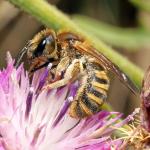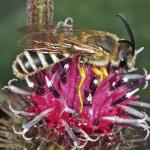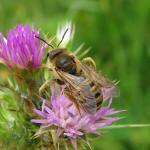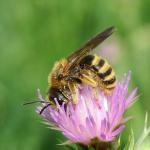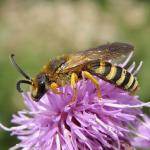Apis scabiosae Rossi, 1790, Hylaeus alternans Fabricius, 1793, Halictus zebrus Walckenaer, 1817, Halictus griseozonatus Dours, 1872, Halictus scabiosae powelli Cockerell, 1931
In the British Isles this large bee is restricted to the Channel Islands where it has long been known from Guernsey, Jersey and Sark. There it is apparently very local and rarely common.
The species has a Western Palaearctic distribution, ranging from the Netherlands to Iberia, east to Greece, Turkey, Iraq and Iran; it also occurs in North Africa (Morocco) (Ebmer, 1988; Ascher & Pickering, 2012).
The Channel Islands are, for a number of reasons, excluded from the geographical coverage of the British Red Data book (Shirt, 1987) and the subsequent review (Falk, 1991).
This Honey Bee-sized Halictus is easily distinguished by the ring-like bands on the tergites. These comprise an anterior and posterior buff band on tergites 2-4 of the females and just a whitish posterior band on segments 2-6 of the very elongate males. The male hind tibiae is almost entirely yellow without the dark marks of species like H. eurygnathus or H. quadricinctus.
The bee is widely distributed in Guernsey where it is generally confined to sandy soils supporting thistles (the late C David, pers. comm.).
Few dates are available for the Channel Islands. A female was collected there in mid-June and males in late July and mid-September.
In the Channel Islands, C David (pers. comm.) found nests in sandy situations, sometimes at the back of a beach and usually in flat soil. In mainland Europe, in favourable conditions, it nests in large aggregations. This is a eusocial species, over-wintered reproductive females rearing more than one generation in a season, with a distinct worker caste. Unusually, several gynes generally establish a nest instead of one individual working alone. Only one of these females develops ovaries and lays eggs; the others act as workers. Eventually the egg-layer drives the workers away before the brood of new bees is reared. These outcasts are then capable of nesting independently or usurp unguarded nests of their own species or those of other halictine bees (Knerer & Plateaux-Quénu, 1967).
Hogweed, wild carrot, a burdock, spear thistle, common knapweed, cat’s-ear and a hawk’s-beard.
No data available.
2019


